When growing peppers from seed, there are a number of problems that can arise during the year. One common issue we are asked about often are various types of spots on pepper leaves.
Based on the appearance and location of the leaf spots on your peppers, the cause may be a non-issue, or it could be detrimental to your plant. In this article, we’ll share how to identify and diagnose different types of spots on pepper leaves.
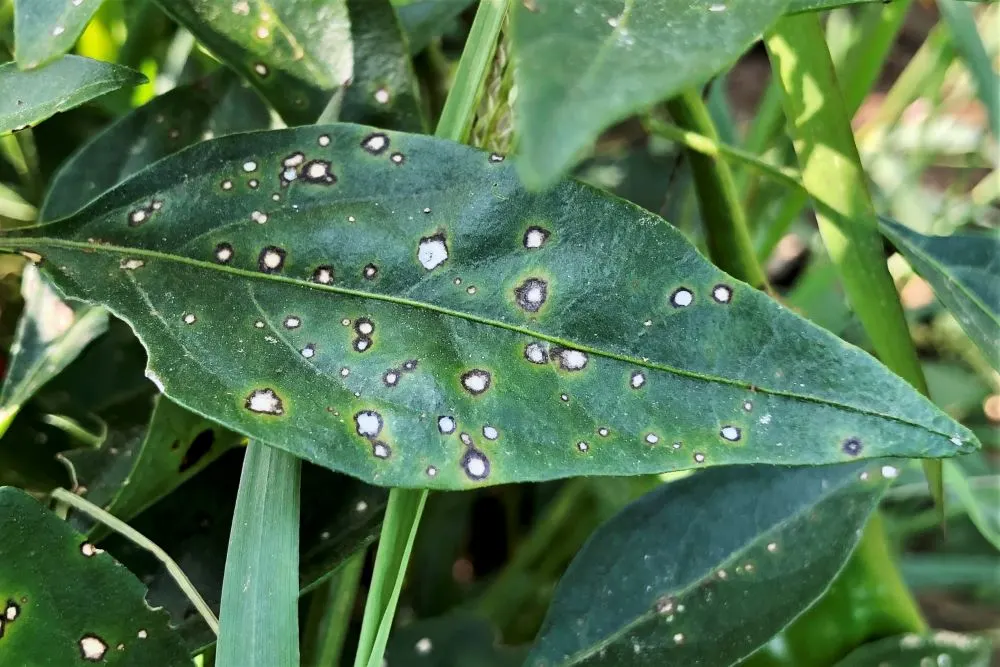
White Spots on Pepper Leaves
The first and most common type of spot seen on peppers are white spots. The color of the spot is just one part of the equation, though. So let’s go through a few different types of white spots on pepper leaves and discuss each.
Sunscald Spots
If you see large, white or gray patches on your pepper leaves, it is almost certainly sun scald that is causing the problem. These can appear as small spots or large patches, especially on older leaves.
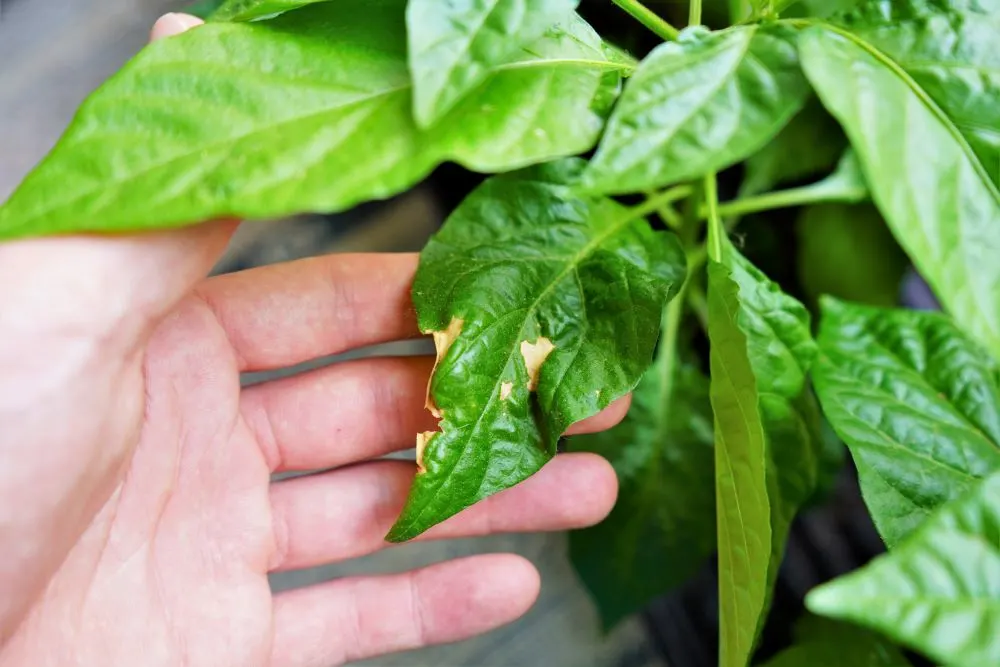
We start here for a reason – it is incredibly common to see sun scald on peppers. It typically occurs shortly after the plants are moved outside into direct sunshine.
Sunscald is basically a plant sun burn. Improper hardening off leads to this type of leaf burn on many types of plants, including peppers. The white spots are burned, dried out leaf tissue that is dead.
The affected parts of your pepper leaves will crumble when squeezed, and will not regain their green color. The leaves may eventually fall completely off the plant. This can be devastating if you move un-hardened plants into full sunshine!
Solutions to sun scald:
- Harden off plants gradually
- Begin hardening off on cloudy days or in shade
- Provide shade during mid-day sun
Sun scald is usually not a death sentence for pepper plants. However, it can not only affect leaves, but fruits as well! If your plant’s fruits are exposed to direct sunlight, the skin may burn and turn white, inviting rot or mold.
Try to keep peppers shaded during the hottest days of summer by moving potted plants into the shade. For in-ground plants, you can use floating row cover or something else to keep the intense mid-day sun from scorching your peppers.
Tiny White Dots
Next up are tiny white spots or holes in your pepper leaves. These tiny spots could be a few different things, so let’s take a look at some pictures for reference.
Plant Edema
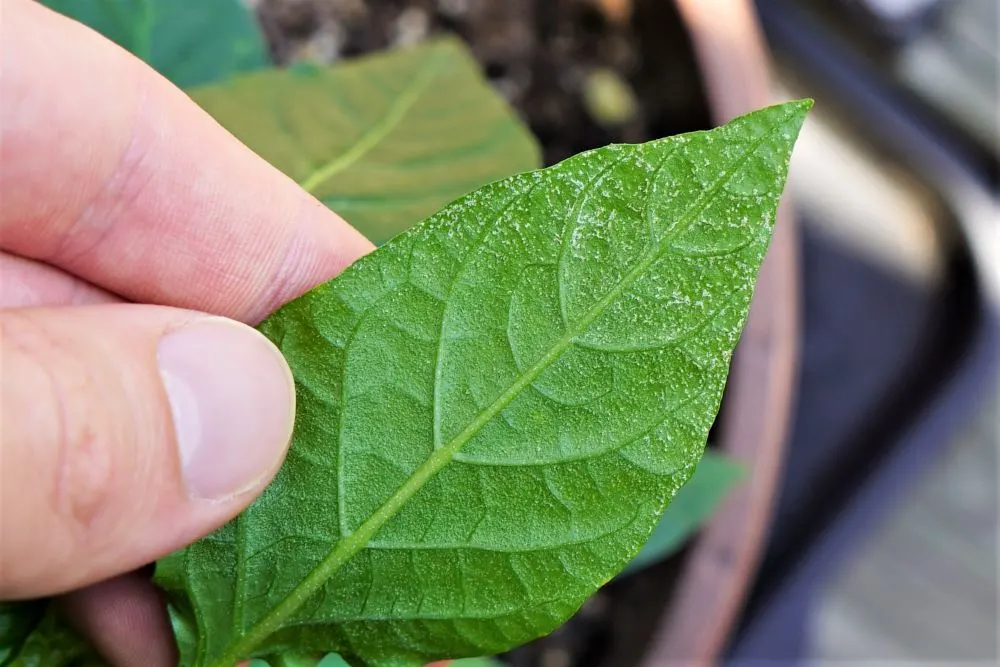
What is plant edema? Edema is a water retention issue that can affect many types of plants. It is not a disease and cannot transmit from one plant to another. It also does not affect all pepper varieties, so some plants may get it while others won’t.
Plant edema is very common on young, indoor pepper plants. The cause is generally believed to be environmental, related to airflow and relative humidity in your grow space. Learn more about plant edema here.
To help alleviate edema in peppers, use a fan to help circulate air and bring fresh air to the plants. I like to have an oscillating fan blowing on my plants for at least 3-4 hours per day while the plants are still inside.
Thankfully, once the plants move outside, the edema has always cleared up for us. Existing edema spots on leaves will not go away, but newer growth should not have any spots.
Insect Damage
While some insects simply eat your plant for a snack (like caterpillars and slugs), others will suck the sap from within your plant. This can lead to white, brown, or yellow spots on pepper leaves.
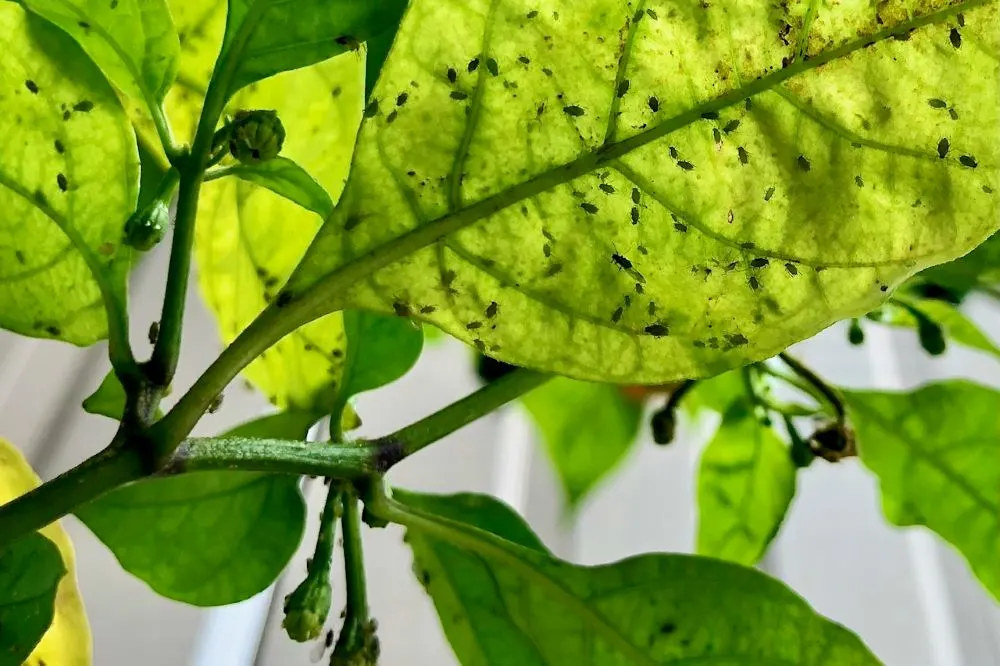
While the spots are not always white, they tend to be random in location. Check under leaves and near younger foliage for any signs of unwanted pests.
Learn more about dealing with aphids and other insects here.
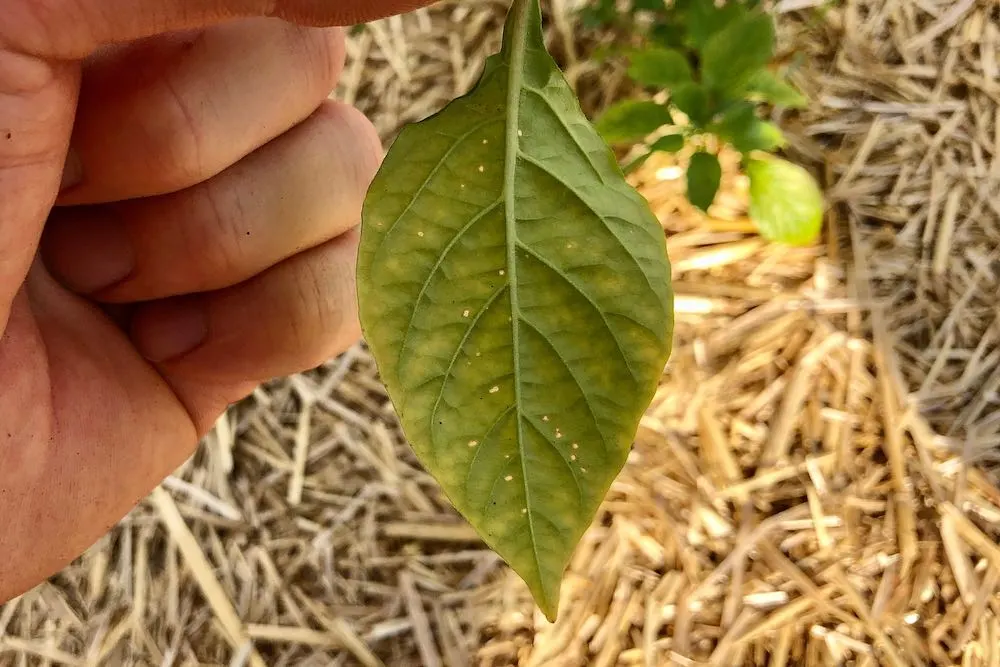
Black Spots
Moving on to the next most common type of spot – black spots on pepper leaves. There are a few possible causes of black spots, from insect droppings to disease. We’ll focus on a common bacterial infection that can impact peppers.
Pepper Leaf Spot
One common plant disease that can infect peppers is called pepper leaf spot. Common in humid, warm climates that get heavy rainfall, frogeye leaf spot can be devastating to your plants.
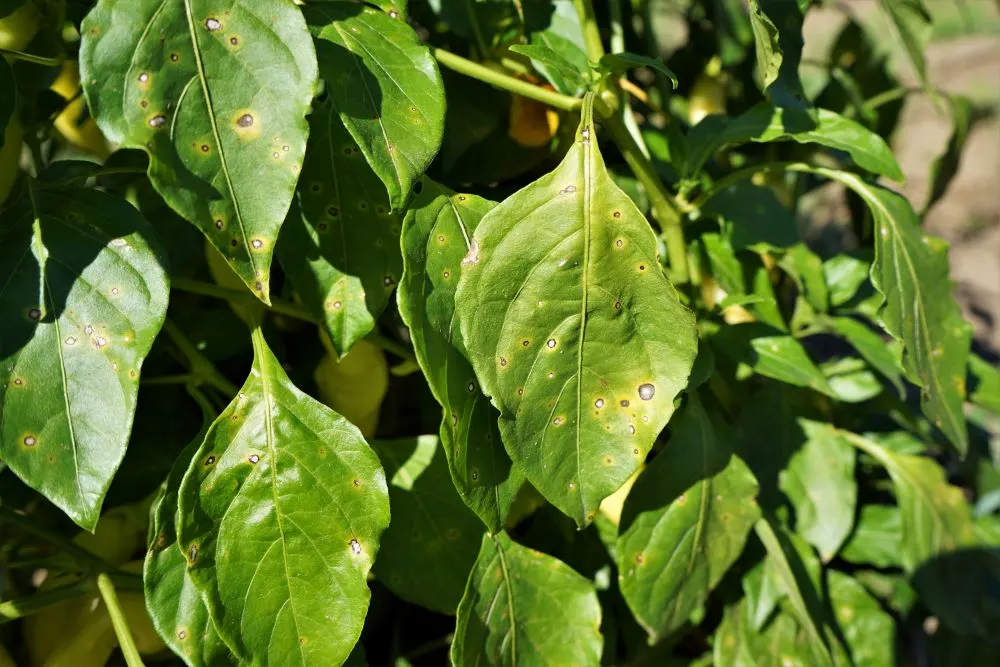
While the disease may not kill your plant, it can quickly impact the leaves of the entire plant. It can also cause poor pepper production and can spread from one plant to another.
Symptoms of pepper leaf spot:
- Numerous black and white spots on pepper leaves
- Spots are white in center and are surrounded with black and yellow
- Spots affecting all or most of plant
Solution for pepper leaf spot:
- Remove the affected parts of the plant and discard them. If only a small portion of the plant is affected, prune it away.
- Spray with an organic fungicide at the directed solution. These can help prevent the spread of the disease by killing spores. Note: Be careful with copper fungicide – do not get it on your skin as it can cause burns.
- Rotate your pepper crops into a different location each year to prevent spores from accumulating in large numbers.
Pepper leaf spot can be carried on seeds, in the soil, or contracted from another plant. To help prevent soil-based spores from landing on your plants, we recommend bottom pruning low foliage throughout the season.
Always be cleanly before heading into the garden to avoid spreading spores from plant to plant. Also, water at the bottom of the plant to avoid water from sitting on the leaves.
Brown Spots
Depending on what part of the spot you are looking at, brown spots on pepper leaves could be caused by one of the issues listed above. However, there is one major, common issue that primarily causes brown spots.
Pepper Bacterial Leaf Spot
It has a similar name to pepper leaf spot, but it is a different bacteria. The appearance of bacterial leaf spot is much different from pepper leaf spot.
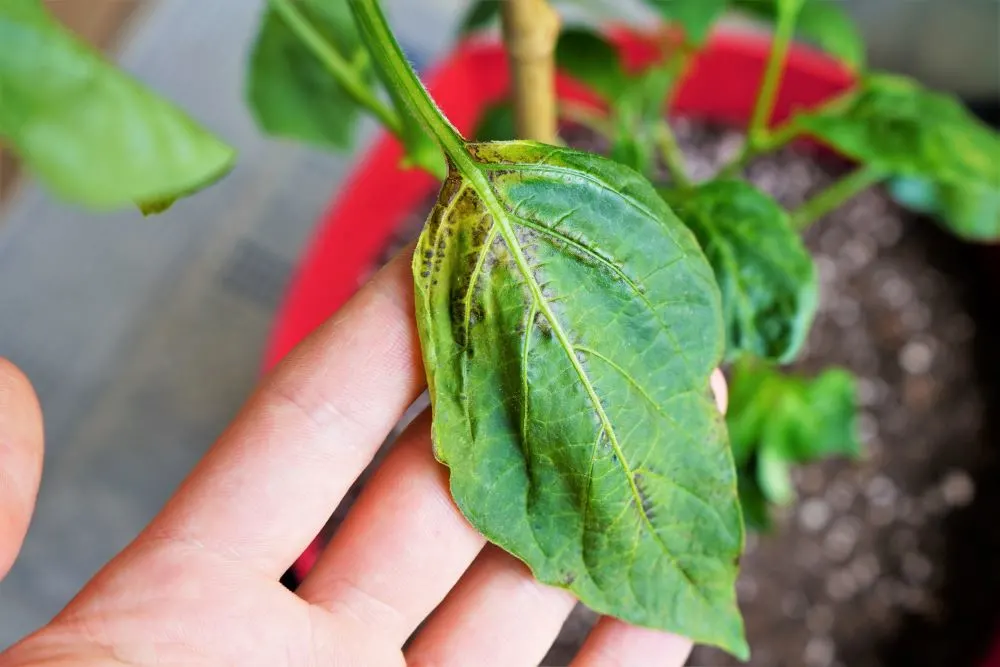
Bacterial leaf spot is caused by hot, humid and wet weather. It is incredibly common in most locations, except in regions where summers are very dry. In other words, unless you live in the desert, you may see this problem.
Symptoms of bacterial leaf spot on peppers:
- Yellow spots turning brown or gray
- Splotchy and not usually circular in shape
- Common in hot and humid climates
Solutions for bacterial leaf spot:
- Remove affected parts of plant and take them far away from the garden.
- Fertilize with higher phosphorus and potassium rich fertilizers. These nutrients help peppers fight off disease and remain healthy.
- Spray the affected parts of the plant with organic fungicide.
- Always work with clean hands and avoid cross contaminating plants.
Tip: Bacterial leaf spot spores develop in water, so avoid getting water on the plant leaves during irrigation. Also, avoid working in the garden or harvesting while the foliage is wet from rain.
If any severely affected plants do not recover from the leaf spot, remove the entire plant and pick up all leaves that have fallen. Better to be safe than sorry, as this bacteria can spread to other plants.
Nutrient Burn
One other possible cause of brown spots on pepper leaves is nutrient burn. Inorganic fertilizers use chemical forms of nitrogen that are readily usable by plants. This works great in the right concentration, but if the levels are too high, the plant can become damaged.
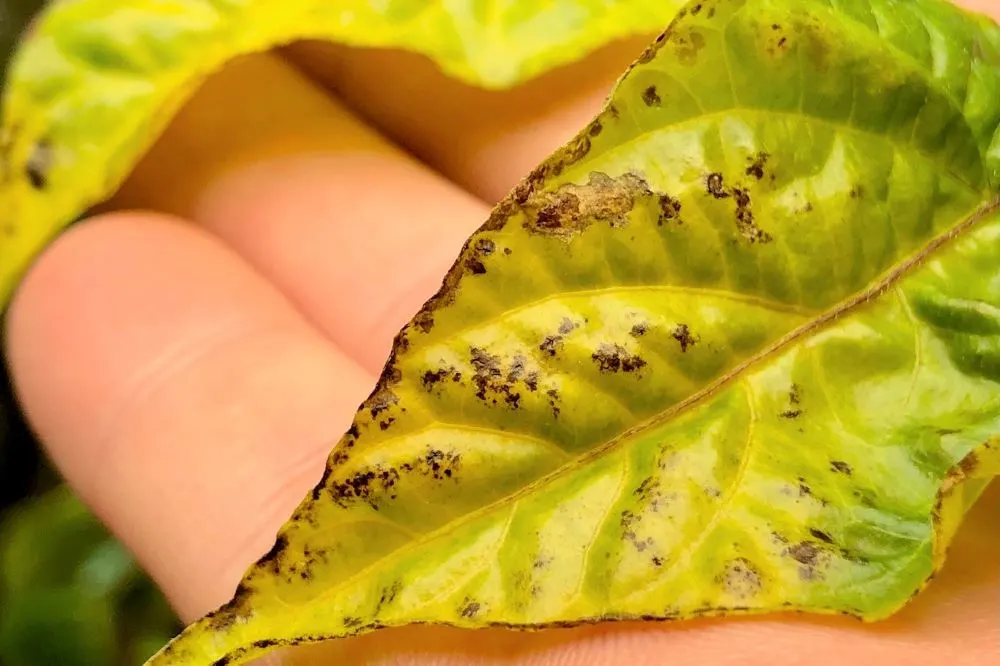
An over-abundance of nitrogen will typically display as brown spots on the leaves, as well as along the edges. If you have not been following the directions on your fertilizer, this may be your culprit.
We always advocate for using organic nutrients, as they typically take longer to become available to plants. Organic substances usually require some break-down by bacteria before they are converted to usable forms of the essential elements.
Read Next:
While this may not cover all of the possible causes of spots on pepper leaves, it covers several common issues. I hope this helps you diagnose your plant’s leaf problem, and feel free to share your thoughts below.


Karen rowley
Wednesday 27th of March 2024
I have brown spots on the underside of the edge of the top leaves on my bell peppers
Barb
Thursday 26th of October 2023
My green bell peppers have small oblong YELLOW areas that aren't really dots but appear to be part of the leaf. Would that be over or under-watering? Or something else?
Kate
Tuesday 11th of July 2023
I read that fungal gnats get into the soil and lay eggs due to too much water and I I’ve noted white spots on the leaves which I removed I use a fan on the plants as I am growing them in an apt now to be transplanted later Is there anything else I can do?
Cynthia Williams
Sunday 28th of May 2023
I don't see any images that show the kind of spots I have on my jalapeno leaves, nor any description of them. Wish I could show you a photo. The spots are white with little wormy-looking trails, as if the leaf were being eaten from within by microscopic worms. Some of the spots are turning yellow and brown, but only those along the edge of the leaves. I can see no pests of any kind on the plant, and it is not sun-scalded; it gets only 2-3 hours of direct sun a day. However, I live in the desert southwest, zone 8/9, so I have to water it almost everyday. It's a potted plant. Bought it a year ago, it produced some mini peppers, then I kept it covered during the freezing nights of winter and it's producing flowers again. But the leaves that have these spots have me worried. Thanks for any advice you can give me.
peppergeek
Friday 22nd of December 2023
This sounds like leaf miners. They can cause damage to the foliage, but the fruits are usually spared. I like to remove any affected foliage to help decrease the population of leaf miners. Hope this helps for next season!
Rik
Friday 20th of January 2023
I live in the tropics and it's rainy season. My Thai green chilli plants have yellow bumps on the underside of the leaves. They're still producing heavily but some leaves and flowers have started to fall. They're grown in containers. Previously, on two different occasions I've had to cut back all foliage to get rid of powdery mildew. Are these yellow bumps a part of the same problem?
peppergeek
Sunday 22nd of January 2023
It is hard to say without seeing, feel free to post a picture on reddit: https://reddit.com/r/peppergeek